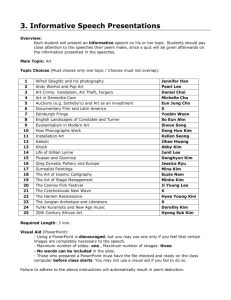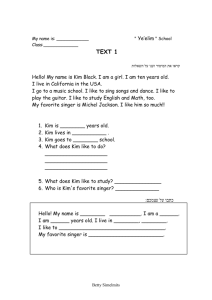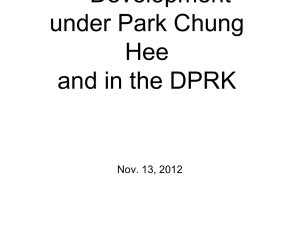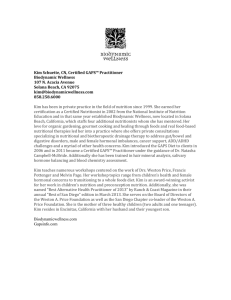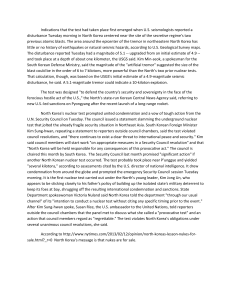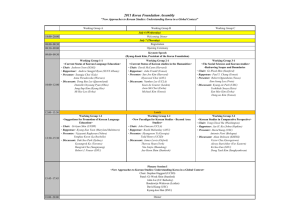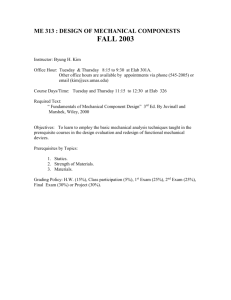Kim Ch'on-hung: Portrait of a Performing Artist
advertisement
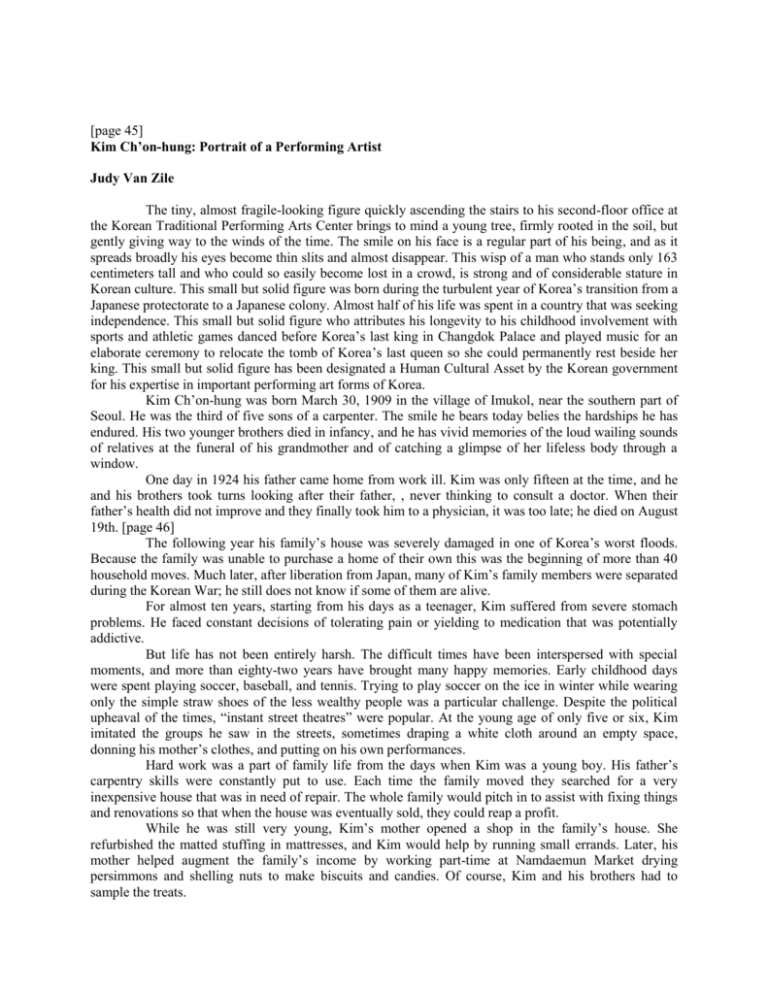
[page 45] Kim Ch’on-hung: Portrait of a Performing Artist Judy Van Zile The tiny, almost fragile-looking figure quickly ascending the stairs to his second-floor office at the Korean Traditional Performing Arts Center brings to mind a young tree, firmly rooted in the soil, but gently giving way to the winds of the time. The smile on his face is a regular part of his being, and as it spreads broadly his eyes become thin slits and almost disappear. This wisp of a man who stands only 163 centimeters tall and who could so easily become lost in a crowd, is strong and of considerable stature in Korean culture. This small but solid figure was born during the turbulent year of Korea’s transition from a Japanese protectorate to a Japanese colony. Almost half of his life was spent in a country that was seeking independence. This small but solid figure who attributes his longevity to his childhood involvement with sports and athletic games danced before Korea’s last king in Changdok Palace and played music for an elaborate ceremony to relocate the tomb of Korea’s last queen so she could permanently rest beside her king. This small but solid figure has been designated a Human Cultural Asset by the Korean government for his expertise in important performing art forms of Korea. Kim Ch’on-hung was born March 30, 1909 in the village of Imukol, near the southern part of Seoul. He was the third of five sons of a carpenter. The smile he bears today belies the hardships he has endured. His two younger brothers died in infancy, and he has vivid memories of the loud wailing sounds of relatives at the funeral of his grandmother and of catching a glimpse of her lifeless body through a window. One day in 1924 his father came home from work ill. Kim was only fifteen at the time, and he and his brothers took turns looking after their father, , never thinking to consult a doctor. When their father’s health did not improve and they finally took him to a physician, it was too late; he died on August 19th. [page 46] The following year his family’s house was severely damaged in one of Korea’s worst floods. Because the family was unable to purchase a home of their own this was the beginning of more than 40 household moves. Much later, after liberation from Japan, many of Kim’s family members were separated during the Korean War; he still does not know if some of them are alive. For almost ten years, starting from his days as a teenager, Kim suffered from severe stomach problems. He faced constant decisions of tolerating pain or yielding to medication that was potentially addictive. But life has not been entirely harsh. The difficult times have been interspersed with special moments, and more than eighty-two years have brought many happy memories. Early childhood days were spent playing soccer, baseball, and tennis. Trying to play soccer on the ice in winter while wearing only the simple straw shoes of the less wealthy people was a particular challenge. Despite the political upheaval of the times, “instant street theatres” were popular. At the young age of only five or six, Kim imitated the groups he saw in the streets, sometimes draping a white cloth around an empty space, donning his mother’s clothes, and putting on his own performances. Hard work was a part of family life from the days when Kim was a young boy. His father’s carpentry skills were constantly put to use. Each time the family moved they searched for a very inexpensive house that was in need of repair. The whole family would pitch in to assist with fixing things and renovations so that when the house was eventually sold, they could reap a profit. While he was still very young, Kim’s mother opened a shop in the family’s house. She refurbished the matted stuffing in mattresses, and Kim would help by running small errands. Later, his mother helped augment the family’s income by working part-time at Namdaemun Market drying persimmons and shelling nuts to make biscuits and candies. Of course, Kim and his brothers had to sample the treats. Days at Kyongmyong School were particularly memorable. Sitting on a traditional-style small wooden platform, with a fire to keep away insects, the students recited Chinese poems, becoming deeply involved in their emotional content. And Christmas always meant a visit to the church next door to the school to receive a gift—even if the children were not practicing Christians, and even if this was the only time they visited the church. In 1922, shortly before Kyongmyong School was closed by the Japanese, Kim began to study at Yiwanjik Aakbu, a court music bureau that had originally been part of the royal palace, but which became a private association after the beginning of the Japanese occupation. Kim was one of nine young[page 47] [page 48]boys selected to become the second group of students to enter the school. He knew very little about the kind of music taught there, but was lured by the opportunity to continue to study other subjects as well. The recommendation of a friend of his father, who was the father of a student in the school’s first class, led to his acceptance and to the beginning of a lifelong involvement with the performing arts. This was a major turning point in Kim’s life. He began to learn to play the music that had been performed in the royal court ᅳ not on just one instrument, but on many of them. Instruction began with the percussion instruments and then proceeded to the string and wind instruments. Melodies and rhythm patterns were first learned by singing them. Then students learned the techniques of playing the various instruments. Melody patterns of the p}yonjong—a large set of metal bells—were particularly difficult to remember. Kim’s creativity led to the development of his own study method. He drew pictures of the bells in their proper arrangement on the wall of his house and practiced striking the imaginary instruments with a stick. At that time walls were made of a mixture of soil, straw, sand, and cow dung that was packed together and then covered with paper. Kim’s repeated banging on the imaginary instruments he had drawn on the wall eventually put holes in the paper, and the wall’s inner content spewed into the room, littering the floor with dust and dirt. Fortunately, his family was understanding. And when examination time came and he drew the slip of paper indicating what piece he had to play, his creative practicing method yielded good results—he performed well. Days at Aakbu were not just study days. One of the teachers encouraged the students to play tennis, and in 1927 set up a tennis court in the front yard of the school. Following the introduction of ping-pong to Korea in the 1930s, students and teachers would play together at night. And there was mountain climbing: memories of beautiful trees and the dew on flower petals reflecting the rising sun; rowing rented boats along the river to get back to the city; and satisfying an outdoor hunger with wine, kim-chee, bean curd casserole, and dried fish while standing amid the noisy crowds at the food carts in the streets. A surprise came shortly after starting classes at Aakbu: eleven students were selected from the school’s all male population to study dance. They did not know what the dances were nor why they had been selected to learn them, but they dutifully stood behind their teachers and imitated the movements they found unusual to them—movements they had never seen before. As they caught glimpses of each other they couldn’t help but giggle at the sight of [page 49] their young male classmates’ attempts at being graceful. But their studies became more serious as a very special day approached. Despite the fact that Korea was now officially a colony of Japan, there was to be a celebration to honor the fiftieth birthday of Sunjong, Korea’s last king. On March 25, 1923, after unpacking their bags at Changdok Palace the young boy students encountered another new experience—for the first time in their lives they had to put makeup on their faces. As their teachers helped them there were constant outbursts of laughter at the sight of the transformation of their fellow classmates. And as he mixed the hard dried powder square with water to create a substance that could be applied to his face Kim was introduced, for the first time, to a white porcelain sink. The houses he had known did not have their own water facilities—water had to be carried to the house from a shared well. When the time for the performance came the young dancers nervously entered the palace room, hands together and eyes downcast, as they had rehearsed so many times. Upon reaching their assigned places they lifted their gaze. Kim vividly recalls seeing the king in his royal seat with elaborate tables of food and flickering candles on either side. Behind the king were guests from Japan and other people of high rank—including Yi Hang-gu, whose father, Yi Wan-yong, was considered by many to be the traitor who sold Korea to the Japanese. A wooden clapper, known as a pak, sounded the introduction to the grandiose music of the court. Nervousness set in, together with a feeling of difficulty in moving his hands and feet. A brief spell of dizziness eventually gave way to relaxation. With his mind finally at ease, Kim was able to dance as he had practiced, and the performance ended without any major mistakes. While the young dancers and musicians rested afterwara in their dressing room, a table was ceremoniously brought in covered with some of the most remarkable foods the young students had ever seen. Their teacher explained that these were special foods served at court banquets, foods identified in the Korean language as those ‘sent down by a royal person.’ A truly memorable day for a young boy about to turn fourteen. A memorable day it was for all of Korea: the first major court-style event since the beginning of the Japanese occupation in 1910, and the last such event ever. Kim believes, however, that because of that event much of the court music and dance repertoire was revived and could be subsequently passed on following liberation in 1945. In the third year of their studies at Aakbu each student began to specialize in a particular instrument, the instrument was not of their own choosing; teachers assigned the instrument, based on each student’s physique and [page 50] [page 51] assumed physical abilities. Kim’s small stature and health problems led his teachers to believe that he did not have the stamina or strength necessary to play wind and percussion instruments. He began to specialize in the haegum, a two-stringed fiddle that has been used since the Koryo period (918-1392), primarily with wind ensembles. It has two silk strings tuned a fifth apart, that are fastened to a sounding board made of bamboo. The bow is made of horsehair, and passes between the two strings. The haegum continued to be the primary focus of Kim’s musical studies for many vears. In 1967, he was designated a Human Cultural Asset for his expertise on the haegum as played for Royal Ancestor Shrine Music. A short vacation trip with his brother in 1924 contributed to both good and bad memories for Mr. Kim. His eldest brother worked in the freight department of the train station in Seoul. He and nis family received twelve free train tickets each year, so in December Kim and his brother embarked on an adventure to Manchuria. Kim’s excitement over his first long train trip was tempered by the tedium of Japanese police continually boarding the train and checking passengers and luggage. After more than twelve hours the train crossed a steel bridge over the Amnok River and entered Manchuria. Large buildings in a traditional style of Chinese architecture, rickshaws, and rickshaw men with their hair in long braids caught Kim’s attention. He and his brother strolled through the streets, taking in all the new sights. Then they shopped for gifts to take home—suger, wine, and especially Chinese cigarettes, which were valued as a special treat since their cost in Korea made them accessible only to the wealthy. As they purchased their treasures they were particularly mindful of what they understood to be the quotas they could bring back to Korea, especially the restriction of ten packs of cigarettes. With sightseeing and shopping done they decided to return across the border for dinner before heading back to Seoul. Again the Japanese inspected passengers and luggage, but this time more thoroughly than before. As Kim and his brother approached the exit gate on the Korean side of the border they were stopped. A policeman inspected their luggage and without any explanation said they must go to the police station. They had no choice but to accompany the officers. Once at the station they were questioned and accused of smuggling; they had ten packs of cigarettes and only two were allowed. They felt certain this was just harassment, and that they had known the proper restrictions, but they had no recourse. They gave up their purchases, paid a fine, were forced to ask for forgiveness, and were ordered to leave immediately. [page 52] The street outside was dark and cold. As they walked Kim watched his brother looking straight ahead, but focusing on nothing. The sadness they felt from their treatment by the police was augmented by their increasing hunger; the bitterness faded as they entered a restaurant with a straw mat on the floor and large pots of steamy boiling noodles. Memories of winter surfaced, with icicles on the roof reflecting the sunlight, skating on the frozen Han River, ice sellers doing rituals in hopes that the weather would stay cold so they could easily obtain their goods, and naengmyoncold noodles that somehow tasted best in the winter. In March of 1926, at the age of seventeen, Kim graduated from Aakbu. Together with most of his classmates he continued his studies in an advanced curriculum. The next month brought both a special performance and considerable turmoil in Seoul. On April 26th Sunjong, Korea’s last king, died. Protocol mandated a forty-day mourning period before the king was buried. In addition, it was necessary to move the tomb of the last queen, Queen Min who had been assassinated in 1895, so that the final resting places of these important people would be together. Both events would bring with them elaborate ceremonies, and both would lure hundreds of thousands of emotion- filled Koreans to the streets of Seoul. At the same time, political activities had escalated and there was keen interest in pushing forward toward independence. Seven years earlier, at the time of King Kojong’s funeral, leaders had staged what they hoped woula be a peaceful demonstration, but their efforts for freedom failed, and there was a great deal of brutality. Now the Koreans had lived through seven more years of Japanese occupation. Wary of possible uprisings, the Japanese militia was particularly on guard against the anticipated high level of emotion. On June 9th there was an elaborate ceremony, similar to a funeral, to move Queen Min s body. Kim and members of the Aakbu staff played music as part of the festivities with Kim playing his primary instrument, the haegum. On June 10th there were elaborate activities for the burial of the king, and there was also the June 10th Independence Movement. As young people distributed fliers advocating independence, tensions rose. There was much shouting, and many people were arrested and tortued. At the young age of seventeen Kim had experienced what many people only read about in history books and fairy tales—the repercussions of an occupied country, movements seeking independence, and performances at a royal birthday and funeral rites, but the practicalities of life moved on, and at [page 53] Aakbu the students began to study singing. Ha Kyu-il, a vocalist who was wellknown among the common people, was invited to teach. Because there had previously been no written documentation for this music, Ha worked to devise a very detailed notation system as he was teaching. This contributed to the eventual publication of notated scores of numerous songs that are still sung today. Eking out a livelihood in the performing arts in any country can be a difficult enterprise; doing so while your country is being jostled back and forth as other countries strive for political superiority makes things even more difficult. Although jostled in his career pursuits, Kim Ch’on-hung managed to maintain continual contact with the performing arts. Upon completion of his preliminary studies at Aakbu he joined the school’s staff, teaching as well as continuing advanced studies. He stayed at Aakbu for many years, expanding his performing abilities, gaining experience in teaching a number of musical instruments, beginning to contribute to the documentation of music traditions by recording selected repertoire items in written notation, and performing in a variety of contexts. Together with Aakbu colleagues, from 1927 to 1931 he performed in outdoor music concerts at Changyongwon at cherry blossom time in the spring. During the same years he performed in live broadcasts of traditional Korean music at Korea’s first radio station, and in the late 1930s he participated in recording music for the performance tours of Ch’oe Sung-hi, one of the earliest of Korea’s dancers to experiment with developing creative dance forms. Despite his commitment to Aakbu and the strong relationships he developed there, the school was not to be Kim’s permanent place of employment. As Japanese control increased, problems emerged regarding equitable treatment and advancement among the staff. In June of 1940, after eighteen years as a student and then staff member at Aakbu, Kim decided it was time to move on. Through colleagues, he obtained a position at a kwonbon, a combination school and union for female entertainers known as kisaeng. Although his work was administrative, involving supervision to insure that the young women were properly trained and scheduling the women to go to restaurants, bars, and private houses, he was continually drawn to watching their dance classes, but within only a year he lost his job. To curtail expenses so that more funds would be available for escalating war activities, the Japanese placed restrictions on entertainment, and several kwonbon were combined. Many staff members were laid off, and since Kim did not have seniority, he was not asked to continue employment, so he moved on to an elaborate restaurant and [page 54] bar to assist with the female entertainers there. In 1942, in an effort to maintain morale among Koreans sent to work in various military-related activities, the Japanese government established three performing groups to travel around the countryside and entertain the workers. Kim responded to a newspaper announcement, sang the mandatory “audition song, “ and became a member of Choson Akdae, the group established to perform folk music and dance. He became a musician with the group, and thus returned to direct involvement with music. During his travels Kim collected small rocks as mementos of the many coal mines where he performed, but his , precious keepsakes were all lost during the Korean War. When winter set in, and travel became difficult, the groups returned to Seoul. This time colleagues suggested that Mr. Kim might find employment as a musician to accompany shaman rituals, so he began to frequent such activities to make the availability of his services known. He was eventually tapped by shamans to join them, and through these experiences was able to learn a great deal about rituals and the differences among those of various regions. Kim’s involvement with dance had begun to increase in the 1930s. Because no court dance had been done from 1910 to 1922, senior teachers at Aakbu attempted to reconstruct the dances of former times based on documents of prior court activities. Following his dance debut at the king’s birthday party in 1923 and his graduation from Aakbu in 1926, Kim continued to learn more about the dance. In the 1950s he opened his own dance studio in Seoul, and in 1956 his students gave their first recital. During this time he also rejoined the staff of Aakbu, which became known as the National Classical Music Institute, and more recently as the Korean Traditional Performing Arts Center. He began to create dances of his own, choreographing more than five dance-dramas based on traditional Korean stories, but always maintaining strong movement ties to the style of court dances and other traditional Korean dance forms. In 1971 Kim was designated a Human Cultural Asset for Ch ‘oyongmu, an important court dance believed to have originated in ritual activities, and one he had learned from his teachers at Aakbu, who had reconstructed the dance from historical documents. Many times he returned to such documents to try to reconstruct dances on his own. In 1983, he staged a reconstruction of Hak Yonhwadae Ch’oyongmu Hapsul, a suite of three court dances that is described in only a general way in several documents. Each of the three dances had been reconstructed previously, but this was the first time an attempt was made to find a way to combine them as a suite, as described in [page 55] [page 56] court documents. Kim’s exposure to dances of other countries also increased over the years. During the Japanese occupation he saw dances performed by the Japanese geisha, and in 1945 he saw a Chinese ribbon dance, which subsequently influenced some of the ways in which Korean dancers manipulated their sleeves. In 1964, while on a performing tour in the United States, he was particularly impressed by a performance of the famous American modern dance company of Jose Limon. Although he has seen many kinds of dance, Kim has never been tempted to try to learn anything other than Korean dance, but he believes the kinds of experimentation that are being done in dance today in Korea are important. He tells his students that they are more fortunate than he: having studied only Korean dance, he stands on only one leg; with their opportunities to study both Korean dance and foreign dance, they stand on two legs, but he is quick to add that any dance style is difficult to master fully, and therefore, it is important to have a solid foundation and pursue a single focus. He also believes there is so much variety in Korean dance that it is not necessary to borrow from foreign dance; it is possible to be creative from a purely Korean dance base. The breadth of Kim’s music studies was not limited to learning how to play many different instruments; it also included learning how to make instruments. He was taught how to construct a piri, a double reed instrument, and had to go to a funeral home to obtain the correct wood, which was the same as that used to make coffins. He used a knife, a drill, and wire to adjust the thickness of the wood, the size of the finger holes, and the distance between the holes in order to make an instrument that would produce the best tones. In 1932 the Japanese government instructed the Aakbu staff to make a set of p’yonjong (the large metal bells) and p’yon’gyong (a large set of jade chimes) to send to Manchuria for the coronation of Pu Yi. Kim observed the process of smelting the metal and obtaining and cutting the jade stones. When the jade chimes were near to completion, one of Kim’s teachers gave him a pitch pipe and asked him to help tune the instrument. Kim also took note of his teachers’s efforts to perpetuate traditional music by documenting it in written form. In 1924 Aakbu teachers began to require that students enhance their studies of music by adding a secondary specialization. Once again, however, the choice of instruments was not left to the students. Kim was instructed to pursue secondary studies on the yangum, a dulcimer used mainly in court music ensembles and to accompany long lyric songs. It has fourteen sets of wire strings. There are four strings in each [page 57] set that are stretched over and through round holes bored in two metal bridges. The strings are struck with a small, light bamboo beater held in the right hand. Kim’s involvement with this instrument led to his authorship, in 1971, of the Chongak Yangumbo, a book of scores for the yangum. Following his days as a student and then staff member of the court music school, his involvement with the female entertainers’ union, and performances as a roving musician and shaman ritual accompanist, Kim was invited to teach music at Ewha Women’s University. This was the beginning of his involvement with the university community. Since that time he has continued to teach at universities in Korea as well as abroad, and has taught both music and dance. Kim’s active life of study and performing did not prevent him from having a rich family life. In 1931 he married Park Jun-ju, the sister of a fellow Aakbu student. Over the years they had eight children—five girls and three boys. Difficult times led to the early deaths of two of the girls, and the 1990 death of a son has now left five children, all except one of whom live in the United States. When Kim’s children were young, they were never really aware of what their father did. Kim Chung-won, his second oldest daughter, recalls being surprised at seeing her father’s students perform in a dance program in the 1950s; she had no idea that he was so involved with dance and that he was so good at training dancers. When she expressed an interest in learning to perform her father tried to discourage her. When she persisted he finally said it would be all right, but that she would have to learn from someone else. She did so, but eventually her father agreed to teach her, and when he opened his own studio she became an assistant to him. Through performances and teaching Kim Ch’on-hung has contributed to spreading Korean dance world-wide, but perhaps his greatest influence outside Korea has been felt in Hawaii. In the 1960s Korean dancer Bae Ha-la, who had moved to Hawai’i in the late 1940s and set up a dance studio there, returned to Korea to study with him. She subsequently invited Kim to visit and teach at her studio. She also sponsored Kim’s second oldest daughter, who emmigrated to the United States and assisted at the dance studio. Both Halla Pai Huhm, as she was known in Hawaii, and Kim’s daughter, as well as Kim himself, taught classes at the University of Hawaii Although Kim’s daughter is no longer very actively involved with dance, she frequently assists with Halla Huhm’s studio performances. Throughout all of his experiences Kim has maintained a sense of humor and an almost childlike delight in small pranks and turning what might be [page 58] dark things into light-hearted jokes. This attitude has permeated his relationships with people, his teaching, and his studying. For example, the yangum, Kim’s secondary instrument, is difficult to play because of the spatial sensitivity needed to strike the right strings with the small padded beater. Kim and other students would hold contests to see who could play yangum best at night—in total darkness. At another time, while he was overseeing activities at the kwonbon, he realized that the young women were particularly averse to practicing a difficult movement pattern in the summer heat. Whenever it came time to rehearse yompungdae, a movement involving many rapid turns, the women decided not to exert themselves. To motivate them he promised a reward—if they would work hard, he would treat them all to popsicles. Practice sessions perked up, and he provided treats for everyone. Once when he was preparing his students at Ewha University for a Christmas performance, he realized that the student who played the tanso, a flute, was not particularly strong musically. He felt it would enhance the performance to have another student, who was a bit more skillful, play from backstage at the same time. Following the performance a colleague told him that he had heard the tanso played incorrectly at one point, but that at the same time he also heard the correct melody coming from somewhere else. Kim revealed his camouflage, and he and his colleague had many a good laugh each time they thought about the incident. On another occasion, when some young female entertainers came to perform at the radio station with Kim and his male colleagues in the 1930s, the gentlemen told them that if they wanted to play well they had first to bow to the microphone. They all then enjoyed a good laugh as the young women got up en masse and dutifully paid their respects to the equipment of modern technology. Professor Lee Hye-gu, a very prominent Korean ethnomusicologist, provides an analogy for Korean culture that can readily be used to describe the life of Kim Ch’on-hung. Professor Lee describes Korean culture as being like a sand castle built by a child at the edge of the water: the child builds the castle, waves come in and tear it down, and eventually the child rebuilds the castle. In a similar fashion, Korean culture is built up, is torn down by foreign invasions, be they through war or simply through contact and exposure, and then the Koreans build it up again. Kim Chon-hung could easily be compared to the child, continually involved with a “castle” of traditional Korean culture. He has endured many hardships and, indeed, turned them to his advantage; he has taken bleak [page 59] moments and made light of them so they could be tolerated; and he has contributed to the life of Korea’s traditional performing arts. He believes he was chosen to do court dance, it was his destiny. He has what some would consider a fatalistic attitude; he has always accepted what life has placed on his plate and made the best of it, and he has always worked to maintain traditional Korean culture. The study of his life is the study of a rather special man, but it is also the study of Korean music and dance and of an important period in Korea’s history. Research on which this article is based was carried out in Korea during four residencies over the elevenyear period from 1979-1990. The material presented here was first given as a lecture on March 31, 1991, for the Royal Asiatic Society, Korea Branch. It is based on interviews with Kim Ch’onhung, his family, and his colleagues, and on Kim Ch’on-hung memoirs as published in the February-December, 1990 issues of Ch’um magazine. Grateful acknowledgment is made to the following organizations for providing funding assistance for research: Korean Culture and Arts Foundation (Seoul); Academy for Korean Studies (Seoul); Korean-American Educational Foundation (Fulbright Program); and International Cultural Society of Korea. Acknowledgment is also made to individuals who provided invaluable translation assistance at various stages in the research process—Alan Heyman, Joo Yun-hee, Kim Sung-ja, Lee Chun-hye, Lee Young-Ian, Gary Rector, Ryu Ran, Um Hae-kyung, and Tim Warnberg, and to individuals who provided helpful comments on early drafts of the manuscript—Karen Jolly, Jane Moulin, Judy Rantalla, and Barbara B. Smith .

